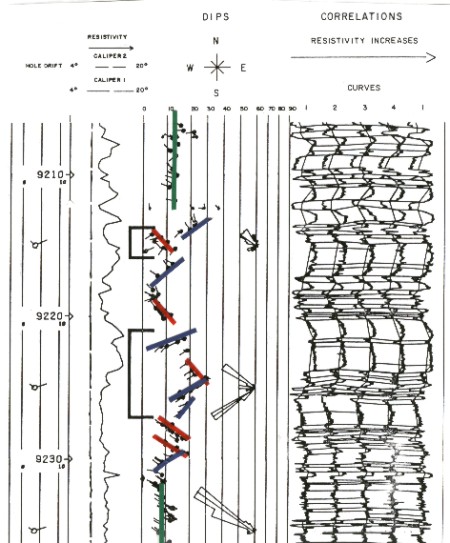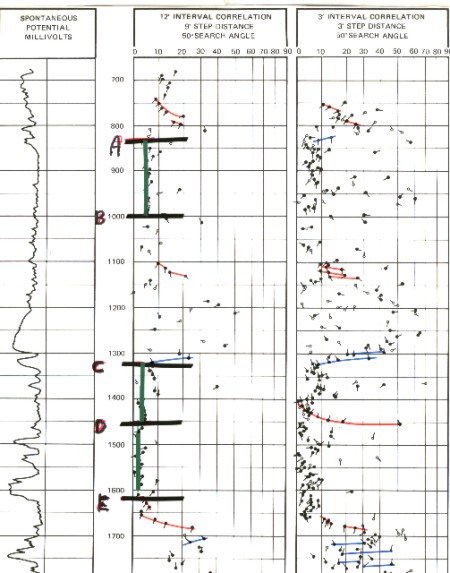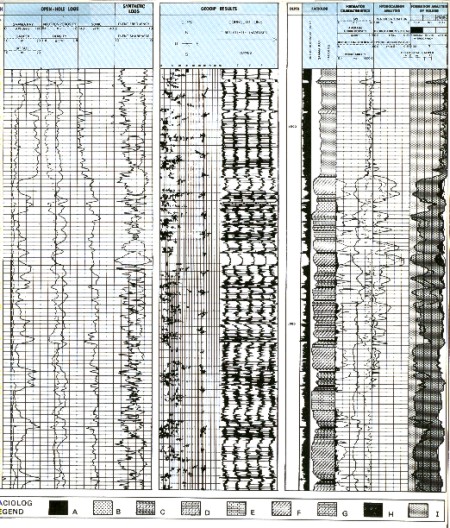|
 Dipmeter Patterns in Sedimentary Structures
Dipmeter Patterns in Sedimentary Structures
Standard dipmeter computation techniques provide information which,
with relative ease, identifies structural dip and major structural
features. Faults, nonconformities, anticlines, and proximity to
diapiric salt or shale domes, or to reefs can generally be recognized,
suggested, or ruled out. For large structures, dip values which
follow relatively constant trends over intervals of appreciable
length are used.
Standard
high density computed dipmeters also display patterns of dip change
which may be associated with smaller structures. Increasing dip
with increasing depth, over short intervals, (RED patterns) may
be related to faults, bars, channels, or unconformities. Patterns
of decreasing dips with increasing depths, over short intervals,
(BLUE patterns) may be related to faults, current bedding, and
unconformities. To be related to stratigraphy, these patterns
usually do not cross major lithologic boundaries.
However,
this rule may be broken if it is known that sediment type changed
during a constant sedimentation cycle. Sometimes, the dipmeter
pattern is the first clue that this might be possible. A review
of sample, core, and palynology is in order if this is suspected.
The
GEODIP and DUALDIP techniques, and their equivalents from other
service companies, reveal such patterns on a much finer scale
than the usual HDT or CLUSTER programs. With
the increased number of dip determinations, it is possible to
relate small scale patterns of dip variations with detailed internal
structures of sedimentary bodies. In many cases, stratigraphic
analysis can still be done on older HDT data, but the processing
and resolution will not provide the same quality of results as
more modern techniques. Because we are stuck with what already
exists in well files, we will illustrate some examples from the
older style logs.
The
image below illustrates how easily and accurately changes in dips in
very thin beds can be detected on the GEODIP arrow plot. The two
bracketed intervals of lengths 2 ft. and 5 ft., have a southwest
dip, deviating abruptly from the west northwest structural dip
of the rest of the section. The southwest dip is assumed to represent
current direction for those two units.

Small scale stratigraphic dips from SHDT DUALDIP
program
Such
breaks in a geological column, as well as other patterns of sedimentary
dips, can be analyzed, along with available information, in terms
of lithology, sequential evolution, and depositional environment.
This works best in shaly sand series, where scatter in dip magnitude,
spread of azimuth variations, and constancy of a preferential
direction indicate various types of internal cross-bedding of
thin or thick layers. In turn, these features show either an intermittent
and rapid deposition, or a continuous one with variable rate,
or reworked sediments. The display of both resistivity and gamma
ray curves curve on an arrow plot permits the analyst to relate
sedimentary dip with lithologic changes revealed by resistivity
or shale volume contrasts.
Non-planar
boundaries between formations signify a break in the sequence
of deposition. When such breaks happen within the unit, and not
at its limits, turbidite, deep sea fan, or similar facies may
be considered. Non-planar dips are indicated when several dips
are found at the same depth with a wide spread in dip angle.
Stratigraphic analysis begins with a review of the well history,
sample descriptions, log curve shapes, open hole logs (shale volume
and lithology), and the dipmeter arrow plot. We try to get three
things from the arrow plot: dip spread (an indicator of depositional
energy), dip planarity (an indicator of bedding type), and dip
patterns versus depth.
Dip
patterns fit one of five general classifications:
 GREEN
Patterns: nearly constant dip and direction, representing regional
dip, sometimes called structural dip.
GREEN
Patterns: nearly constant dip and direction, representing regional
dip, sometimes called structural dip.
 RED
Patterns: increasing dip with depth, representing drape, down
dip thickening, or differential compaction.
RED
Patterns: increasing dip with depth, representing drape, down
dip thickening, or differential compaction.
 BLUE
Patterns: decreasing dip with depth, representing current bedding.
BLUE
Patterns: decreasing dip with depth, representing current bedding.
 BLACK
Patterns: abrupt changes or breaks in dip and/or direction, representing
unconformities, or erosional boundaries between stratigraphic
units.
BLACK
Patterns: abrupt changes or breaks in dip and/or direction, representing
unconformities, or erosional boundaries between stratigraphic
units.
 YELLOW
(RANDOM)
Patterns: caused by poor hole condition or random stratigraphic
events, such as pre-depositional burrows and cracks.
YELLOW
(RANDOM)
Patterns: caused by poor hole condition or random stratigraphic
events, such as pre-depositional burrows and cracks.
The
color assignments, namely green, red, blue, black, and yellow,
are purely arbitrary but have become an industry standard by common
usage. Appropriately colored pencils or ink markers are used to
join dip arrows to emphasize the patterns. The five patterns are
illustrated schematically in the left side of the image below. Variations
of the basic patterns, called features on the illustration, are
given on the right hand side.

Dipmeter patterns and features
To
begin analysis, start at the top of the log (or somewhere above
the zone of interest) and draw in the green, red, blue, and black
patterns, in the order listed. Be careful not to cross a major
change in dip direction with one of these patterns. Join arrows
which are fairly close in depth. Use the gamma ray, SP, and resistivity
curves as guides to formation boundaries. Stratigraphic units
seldom cross obvious boundaries, but this rule may be broken,
as discussed earlier.
The
end of a blue pattern can be the beginning of a red pattern and
vice versa. Red and blue patterns should have roughly constant
dip direction, or else they are not really patterns, merely random
dips. In addition, red patterns must have a break at the base
and blue patterns must have a break at the top of the pattern.
Not all the results need to be included in every pattern.
In
the example below, the top half of the log shows a trend
of dips at 4 degrees downward to the south southwest - a GREEN
pattern between "A" and "B". This is most
evident in the left hand log, run with a long correlation interval
to enhance regional and structural features. The horizontal line
at "B" indicates a break in trend - a BLACK pattern.
This is followed by stratigraphic BLUE patterns representing cross-bedding
in a meandering stream point bar. This is best seen on the right
hand log, run with a short correlation interval to emphasize stratigraphic
features.

Colouring and analyzing dipmeter patterns
The
scattered dips below the RED pattern represent festoon type bedding.
This is followed by a BLUE pattern indicating foreset beds in
the base of the sand, probably in a channel fill environment.
This is followed by regional dip of 2 degrees to the west between
"D" and "E".
For
stratigraphic work, do not join points across a dissenting dip.
The dissenting dips are the clues to stratigraphic changes. Join
arrows of about the same dip direction. The greater the dip magnitude,
the more similar the azimuths should be. Conversely, when very
small dips are considered, the azimuth can vary up to 90 degrees.
However,
some stratigraphic structures have a large spread in dip angle
or direction or both, giving a solid clue to the structure's identity.
In these cases, joining dips into patterns may be fruitless or
impossible. Instead, an outer boundary may be drawn to reflect
the spread. An azimuth frequency diagram will probably be useful
in defining dip direction.
Keep
the scale of features in mind. Structural features (except faults)
may encompass hundreds or thousands of feet of data. Stratigraphic
features may be superimposed on the structural patterns, and encompass
only a few feet to several hundred feet. However, drape over reefs
and differential compaction may persist over several thousand
feet, and these features are associated with stratigraphic traps.
Red patterns associated with faults and unconformities tend to
show greater variations in dip magnitude over smaller vertical
intervals. Blue patterns associated with sedimentary structures
are usually short (up to a few feet on the vertical scale), whereas
the blue patterns that are a reflection of faults and unconformities
generally persist over much longer intervals.
A
dipmeter log should always be correlated with the rest of the
open hole logs when the patterns are being drawn. A computed lithology
log is especially helpful, as shown below, to prevent
drawing silly patterns which cannot be supported by the obvious
lithology. For instance, it would make little sense to unite in
the same blue pattern two arrows belonging to different lithological
units. A good well history and the formation tops should also
be at hand, since most major unconformities will occur at one
of these points.

Analyze dipmeters along with all available data
- not in isolation
|

